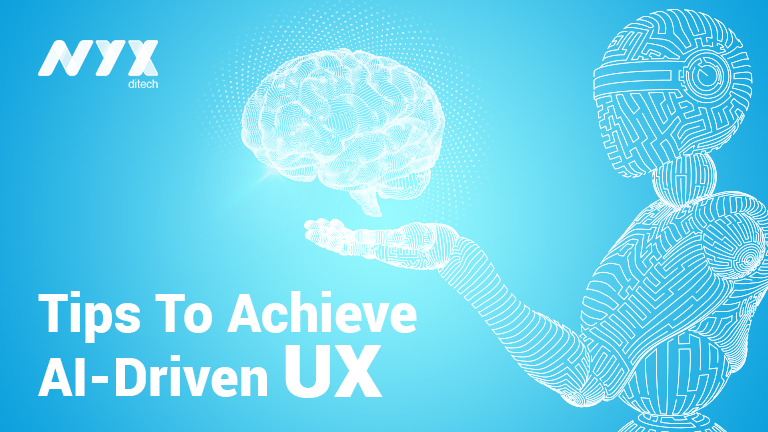Handy Tips To Help You Achieve AI-driven UX

Machine learning and AI-driven UX design are inseparable as they are both invaluable to improve the quality of product experience. Machine learning is built upon complex algorithms that learn from different data sets or human interactions. Over a period of time, it gains insights to act on a certain instruction or predict outcomes on its own. AI-driven UX and Machine Learning-based Predictive User Experiences are incredible playgrounds for UX designers. It is the challenging combination of technology and people that make it so hard to design seamless experiences. Designing AI-driven UX is the process of designing meaningful AI-driven products or services; it comes with many challenges
The design makes the products more accessible to the user. From the perspective of a designer, it is their ability to keep the user in mind and deliver positive interactions that matter the most. With more AI in UX design, designers will have to know more about data and how an algorithm responds to a specific data set. For example, if you are designing a fitness app, you need to study the health care data to make more credible assumptions. The data can say a lot about where the user belongs to, age groups, locations, body types, etc.
The future of machine learning will depend a lot on how designers apply their own knowledge and the effectiveness of AI to bring a better user experience for every individual. Here are some design principles you need to know before designing good AI products:
Design For Humans
The key purpose of AI is to serve human interests. It should help humans in making decisions, derive insights, and in automating our world. It is imperative for designers to maintain a human-focused approach while creating AI-driven UX. People should be kept in mind throughout every step of the process; right from discovering the problem, building models, iterating and calibrating the experience.
When you design an AI-driven experience, you are building calibrated trust with your user. The magnitude and accuracy at which AI helps drive the experience to cultivate trust between the user and the experience. This trust helps in creating habit-forming behavior, whereby people will be internally and externally more motivated. As a designer, you should always be eyeing to solve a particular problem, and if AI capabilities can solve it better?
Keep It Transparent
AI derives meaningful insights from complex data sets to produce recommended actions. But, there are chances that the AI-generated content may not be accurate. This is seen mostly in cases when there is not enough data or feedback to learn from. We need to differentiate or mark out the content generated by an algorithm so people know that the data is not fully accurate. This way a customer will know whether to trust the data or not.
Explain How Machines Learning Works
Sometimes, it becomes incredibly hard to explain how machine learning algorithms have come up with a certain recommendation. But, we should let people know the reason why they are seeing such results. That said, we don’t need to give a detailed account of how a neural pathway works. A better understanding of how an ML system work is essential to keep people interested in the system. We should give users hints about what the algorithm does or what data it uses.
Build The Right Communication
We should understand how to make our design systems more practical and widely usable for all types of users. Sometimes, it’s funny how things turn up when people try to communicate with chatbots. Extensive testing can help us prevent awkward conversation issues. However, a designer needs to be fully aware of user expectations and communicate these issues to the developer so they can fine-tune the algorithms to prevent bad responses.
Offer The Right Training Data To AI-Driven UX Designers
A UX team provides valuable guidance to the engineering team based on the insights collected from training data. While the engineers are focused on finding the best algorithm for the task, UX people help define user expectations to ensure the end product addresses needs more effectively. Google reportedly hires “content specialists”, experts in the domain of the product who help build training data set. In an AI-driven UX project, you need designers and developers to work closely with each other to design better products and experiences.
Test All Your AI-driven UX Products
Depending on the application and what data is available, there are different types of testing methods for AI products. However, Testing the UX of AI products is usually more difficult than for regular apps. You can Test the AI UX with methods like the Wizard of Oz testing. The Woz method is a popular method in the initial prototyping stage to check for any inaccuracies in product response.
Building an AI-driven UX for products has many benefits. it is able to predict user behavior and immediately understands the best options to perform the function. However, with the increasing adoption and acceptance of new AI-appliances, it is important to set the right expectations so people will know what they can or can’t achieve with the AI product. You should allow users to provide feedback at all times, and even come up with suggestions on how to improve the product.
Contact Us today for your design specific requirements
Interested in building a career in UX design? These tips will help

